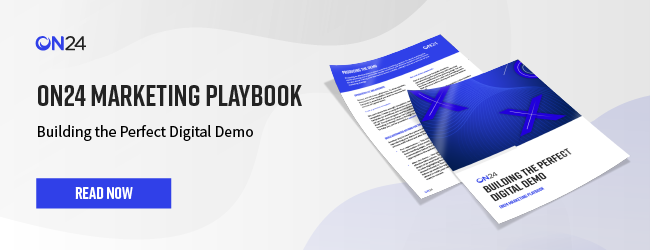How to Drive Successful Demos With Webinars

Running a successful, always-on demo program with webinars can help boost a brand, engage audiences and help organizations identify and qualify leads that are a viable fit for your service.
Think about it: virtual demos allow companies like yours to show off products in real-time to anyone anywhere in the world. They can entice new buyers for your brand and generate new leads. Offering a visual guide to interested prospects could help turn would-be customers into happy clients. Most importantly, they are extremely cost effective for your business.
Of course, accelerating sales through digital channels such as webinars is easier said than done. Setting a program up takes time and planning. Maintaining it requires a long-term vision. And the skills required to run a live webinar demo are different from those required for a live in-person presentation. For example, a salesperson can’t read a digital room as well as they’d be able to face-to-face.
But the benefits of running a successful digital demonstration far outweigh the costs. Done right, a webinar can help your organization:
-
- Connect with audiences at any time of the day in any region
- Analyze, qualify and route prospects to the correct nurture program
- Automatically alert sales teams of prospect activity
- Gather data and update account information
- Provide marketing and sales with a powerful, always-on resource for growing pipeline
So, how do you create and run a successful webinar program? Read on to learn just exactly what a webinar demo is, the essential strategies for running a successful product demo over webinars, how to incorporate them into your content strategy and discover general tips and tricks to set your program up right.
Why Use Webinars for Product Demonstrations?
Webinars are great tools for product demonstrations because they provide a direct, two-way line of communication between a prospect and brand virtually anytime, anywhere. With webinars, organizations can scale product presentations to connect with markets in certain verticals, regions or languages and more.
A webinar demo is also highly customizable and provides brands with the ability to showcase their products and or services through a high-quality production in a clean, branded environment. In other words, using a group webinar for your product demo is a highly effective way to market your brand.
With these two elements — two-way communication and highly customizable environments — brands can showcase virtually any product they wish, no matter how big or small, in as much detail as they want. And, because the presentations are digital, brands can market their strategy on the global stage.
But the most valuable reason to market through webinars is the data. With a sophisticated webinar platform, organizations can collect first-party data and seamlessly integrate that information into both sales and marketing tech stacks.
With an integrated platform, sales can get real-time information on what activity an account is taking across a digital experience, right down to:
-
- Time spent in a webinar
- Resources downloaded
- Questions asked through an embedded Q&A, chatbot or email tool
- Questions answered through poll and survey tools
- Additional content consumed through a content hub
Four Reasons Why Webinar Demos Are Essential for Brands Today:
-
- Direct, two-way lines of communication between a brand and a prospect
- Fully customizable digital environments that showcase a brand’s design
- Professional-grade demonstrations that can be scaled and delivered anywhere in the world
- Detailed first-party data that can seamlessly integrate with sales and marketing tech stacks
Four Elements for Effective Product Demonstrations

There are four elements organizations typically use to run an effective product demonstration. Let’s take a look at these now.
1: Keep Specific Features and Benefits at the Forefront.
Your company’s solution may be feature-rich and cost-effective, but one demonstration isn’t going to cover all the intricate details. Remember: it’s very easy to overload customers with information, causing them to only remember a fraction of what you said.
If you are demonstrating to a specific customer, then structure your presentation according to their needs; otherwise, make sure the features and benefits of what you are demonstrating always remain the focus of the presentation.
2: Sell the Solution, Not the Product.
Product demonstrations need a two-step approach. Step one: show the product and its benefits to your customer. Step two: tell the customer how they will benefit from using your product and why they need it.
Remember to sell the customer your solution by:
-
- Empathizing and identifying with their challenges
- Painting a visual picture of the problem being solved in the future
- Demonstrating how this product addresses and solves their concerns
- Selling them the vision and how your product is their solution
3: Highlight Your Product Differentiators.
Most businesses exist in a very competitive space. Similar products will have to vie for prospect attention and interest.
So, how will you break through the noise and stand out from your competitors?
As you plan for the product demonstration webinar, ask yourself:
-
- What is your unique selling proposition?
- What does your ideal customer look like?
- What would be their needs/wants?
- How do we meet/solve those needs?
- What things motivate their buying habits?
- Why did they select you over another company?
- What positive feedback have you been provided?
Simply put, offer something that your competitors don’t. It should be relevant to the person you are pitching and setting you apart from other businesses.
4: More Demonstrations, Less Verbalization.
There is a thing called PowerPoint fatigue, and it is a real issue no matter whether you are conducting a live demonstration or a webinar. People often have to endure multiple presentations weekly, and boredom can quickly set in.
Reading from slides will simply not be enough to create a memorable demonstration. If your purpose truly is to demonstrate your product/service, then the product/service needs to be the focal point — not slides.
Get to the point of your demo quickly and make sure you’ve customized the presentation for your specific audience. Things to keep in mind include:
-
- If demonstrating software/digital products, ensure it is fully loaded (including updates) and ready to go. Delays interrupt the flow, and people will check out.
- Engage the audience. If you’re presenting to a small group of prospects you know, make sure you mention them by name to set the tone and make things personable.
- Pause between sections and add follow-up questions to keep people engaged to prevent boredom from setting in.
- Allow the proper time for questions and answers.
- Ask questions about their needs and how your brand can help. Take notes and, if you can at the moment, address those concerns. Presentations such as this should be conversations, not monologues.
How Product Demo Webinars Can Help Create Brand Awareness

People are generally quite visual and are more likely to remember a graphic over recalling text from memory. Effective demonstrations also appeal to emotion, provide information, and entertain or inspire. Pick which emotion resonates most with your audience and tailor a presentation to it.
For example, if your product is a household cleanser, you can capitalize on the frustration that parents feel when their kids make a mess or bring germs home from school. That will resonate with your audience. Then, you can showcase how your product provides a solution. They will be captivated at the start because they can identify with what you are saying.
You create that emotion to arise within them and visually walk them through their solution to their problem.
The initial presentation should be a soft sell. You are selling a solution based on customer experience and benefits to either them personally or their business. A smooth, professional presentation boosts credibility and inspires confidence.
People are generally quite visual and are more likely to remember a graphic over recalling text from memory. Effective demonstrations also appeal to emotion, provide information, and entertain or inspire. Pick which emotion resonates most with your audience and tailor a presentation to it.
For example, if your product is a household cleanser, you can capitalize on the frustration that parents feel when their kids make a mess or bring germs home from school. That will resonate with your audience. Then, you can demonstrate the product by giving the solution. They will be captivated at the start because they can identify with what you are saying.
You create that emotion to arise within them and visually walk them through their solution to their problem.
The demonstration should be a soft sell. You are selling a solution based on customer experience and benefits to either them personally or their business. A smooth, professional presentation boosts credibility and inspires confidence.
How Can You Incorporate Product Demo Webinars into Your Content Marketing?

Showcasing your product or service through webinars is a great method of growing leads. It also can be a very simple operation.
For example, a short 30-second video highlighting key points of a product can pique interest. These short videos can also be shared over social media, email or even embedded on a website.
A webinar presentation series is another method one could use. By creating a series, a brand can take its time highlighting features, use cases and more. A series can also help brands identify the most engaged — and likely to buy — audiences.
Really, incorporating webinar demonstrations into your content marketing program is simply a question of imagination. If you’re considering bringing product demonstrations closer to your content marketing programs, think about how you’ll integrate the two and which channels to utilize.
Here are a few options to consider:
-
- Website homepage
- Social media
- Email campaigns
- Landing pages
- Blog posts
- Community networks
- Newsletters
- Paid ads
- E-books
Remember: integration can be as simple as including a link in a post (just be sure to track your clicks via UTM codes) or as complex as a full quarterly campaign.
How To Distribute Product Demo Webinars In Five Steps

When it comes to promoting your webinar presentation, it’s important to have a promotional strategy in mind. A word of caution: don’t confuse tactics for strategy.
For example, if you promote a link to your demo webinar to a social media channel — that’s a tactic. A strategy, conversely, has a specific, measurable goal in mind and can incorporate a variety of channels (email, social media, paid advertising, etc.) to achieve that goal.
When it comes to creating a strategy to promote your product demo webinarhttps://www.on24.com/faqs/product-marketing-strategy-guide/, there are a few things you’ll want to do.
1: Develop Your Goal
Sit down with your sales team and discuss what it is you want to accomplish. Is it getting audiences to attend a general presentation? Creating a demonstration for a specific industry? This is also a good time to look at historical data to see how often people attend demos and which demos tend to be more successful than others.
From here, marketing and sales teams can set SMART goals (Specific, Measurable, Achievable, Relevant, Time-based). This is also a good time to document how you’ll track your goals, registrations and more.
2: Identify Your Channels
The channels you use to reach your audiences will depend on the goals you set. For example, if you’re targeting leaders within a specific industry, then you’ll likely make use of targeted emails, paid social media messages and other paid activity.
If you’re planning to promote an always-on demonstration of your platform for a general audience, then you’ll likely want to take advantage of owned channels like organic social media, emails, newsletters, blogs and more.
For webinars, however, there is always one crucial element that each channel should point toward: the landing page.
A landing page is a simple page that users can visit and decide whether they want to sign up for a webinar — in this case your demo — or skip. The secret to a good landing page is to keep both the copy and the form concise.
3: Create Your Content
Okay, so you’ve identified the channels you want to use in your webinar marketing strategy. Now, it’s time to develop the content you’ll use. These can include infographics, short promotional videos and, of course, copy.
Remember: you may need to create slight variations on your content to take full advantage of the channels you use. For example, the voice and tone of social media posts for your sales team is going to be different from the voice and tone of posts coming from your main corporate accounts.
Speaking of variations, this is also the time to develop A/B tests in your copy and/or design. Doing so will help you better understand how you can reach out and connect with your audiences.
4: Inform Partners and Distribute
Right. So you have your strategy, your channels and your content. Now, it’s time to deploy the org.
In particular, you’re going to want to take advantage of your sales organization. Your sales team is a great partner in promotion. They know the prospects that are interested in your solution and the audiences that are piqued by your product. Best of all — if they’re in a specialized field — they know how to talk to them.
Present the sales team with a sales kit and ask them to reach out as your marketing team starts promotion. Here, incentives work well. Encourage your sales partners to go the extra mile with incentives like gift cards and nice swag.
5: Measure Your Success
Finally, it’s time to measure your efforts. Doing so will help you refine your demo program’s strategy. Examine your A/B tests, take a look at sales-generated leads and identify statistically significant winners.
This is also a good time to assess the effectiveness of your landing page. Is it driving conversions? Are those conversions primarily owned (email, social media, paid ads) or organic (SEO)?
Take your findings, celebrate your successes, understand any failures and set out a plan for optimization.
Quick-Win Tactics To Drive Product Demo Registrations

Don’t have a lot of time on your hands? Don’t worry. In lieu of a structured strategy, use these tactics below to drive some quick wins:
-
- Create a search-engine-optimized landing page
- Promote the webinar to a current subscriber base via newsletter
- Use to your social media platforms to generate intrigue
- Offer incentives
- Co-market the demo with a partner — this both expand your reach and creates a unique use case that may resonate with an audience
- Survey participants and the end of the presentation and learn what they want to know
- Make your webinar demos available on-demand
Webinars can be extremely informative and have a huge potential to drive sales. They do not have to be one-on-one meetings but can include multiple participants via video conference.
Using content marketing strategies to either boost views or drive registration is the most effective and time-efficient way of generating interest. Be sure to create a buzz beforehand and follow up a day before the event with a reminder. Create intrigue and avoid overloading your webinar audience with too much information, fostering the most engagement.
These are just the basic tools for a successful webinar. Getting registration rests on marketing and generating a strong call to action. Following up will keep customers engaged and in the sales funnel to generate and drive sales. For a complete resource on running high-impact events, explore our webinar guide to enhance your strategy.


